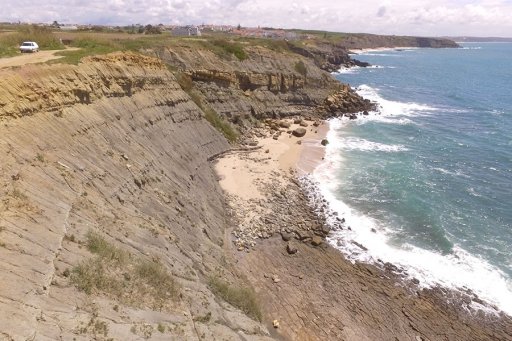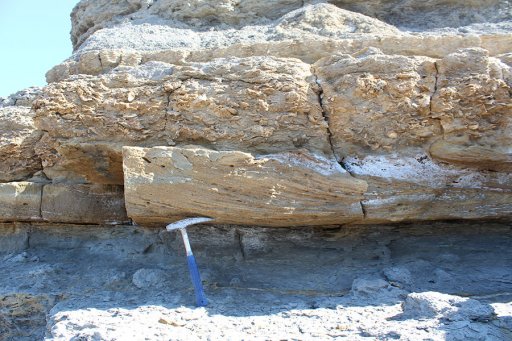High-Resolution Sequence Stratigraphy (Portugal)
This pioneering, comprehensive, and hands-on course, is applied to 3D Geological and Fluid Flow Modelling, in exploration and hydrocarbon production.
- Course Type
Field Course - Duration
5 days - Thematic
Geosciences - Location
- Country
PORTUGAL -
Satisfaction rate
Highlights:
A Jurassic shallow marine succession crops out along Consolação beach, NE from Lisbon. Field work will be supported by drone acquired high-resolution photo-mosaics and a nearby well log. All data from outcrops collected by attendees will be used in-class through stratigraphic correlation exercises.
Why HR Sequence Stratigraphy is still important?
Oil & Gas Industry today employs a broad range of advanced, cutting-edge software tools for geophysical processing & interpretation, geological modelling, and flow simulation & history matching. However, if not combined with the right stratigraphic interpretation and modelling skills, the use of these tools alone is not enough to protect business.
Frequently, misrepresented or neglected geological features may jeopardize asset value by generating reservoir flow models with poor predictability or inability to match production history. One of the main factors impacting the quality of the geological characterization is the stratigraphic compartmentalization of a reservoir, which is effectively addressed through sequence stratigraphy. Accurate sequence stratigraphic framework contributes to reliable hydrocarbon volume calculations, to the correct assessment of reservoir continuity and compartmentation, and to the representative distribution of petro-physical properties in 3D volumes, to name but a few examples.
Main Objectives:
Upon completion of this course, attendees are expected to:
- Master the principles, concepts, and the method of sequence stratigraphy;
- Assess the quality of available data, integrate different sources of information, and qualitatively examine uncertainties related to the interpretation of high-resolution sequence stratigraphy framework;
- Understand the impact of high-resolution sequence stratigraphy on 3D geological and flow modelling, and how to adjust those models to the historic observed production data;
- Incorporate the method of high-resolution sequence stratigraphy on their 3D geological and flow modelling routines to support reservoir management and implementation of production development projects.
Learning Approach:
Learning-by-doing, based on extensive in-class exercises and a field trip. Participants will grasp the method of sequence stratigraphy that will enable them to use it on their daily office routine, no matter the modelling platforms their Company adopts.
HSE Requirements:
Each participant is required to provide a yearly medical certificate before attending this field course. Also, participants must wear sturdy shoes (suitable for pebbly and rocky shore) and bring clothing for hot day time temperatures (sun hat, sun glasses, etc.).
Course Agenda:
Day 1: Transfer from Lisbon to Consolação in the early morning. Classroom activities.
Day 2: Classroom activities and field trip: shallow marine setting.
Day 3: Field trip: shallow marine mixed and siliciclastic settings.
Day 4: Field trip: shallow marine to fluvial settings.
Day 5: Classroom activities: exercises and closing. Transfer to Lisbon at late afternoon.

Prerequisites
This course is for any geoscientist with a basic knowledge of geology, and any participant at bachelor or master level. Participants must be in good health and physical conditions to attend.
Lecturers
-
 Dr. MAGALHAESMagal is Research Associate at Universidade de Lisboa. His experience includes over twenty years of practical application of high-resolution sequence stratigraphy through reservoir characterization and zonation, 3D geological modelling, and reservoir management. Besides, he was Lecturer in Brazilian universities and an Instructor of Sequence Stratigraphy and Sedimentology with Petrobras. Having published several papers on these topics, he is currently also a reviewer for Marine and Petroleum Geology, Geological Journal, Journal of South American Earth Sciences, and Arabian Journal of Geosciences.
Dr. MAGALHAESMagal is Research Associate at Universidade de Lisboa. His experience includes over twenty years of practical application of high-resolution sequence stratigraphy through reservoir characterization and zonation, 3D geological modelling, and reservoir management. Besides, he was Lecturer in Brazilian universities and an Instructor of Sequence Stratigraphy and Sedimentology with Petrobras. Having published several papers on these topics, he is currently also a reviewer for Marine and Petroleum Geology, Geological Journal, Journal of South American Earth Sciences, and Arabian Journal of Geosciences. -
 TERRA G.J.S.Gerson J. S. Terra is a carbonate sedimentologist who joined PETROBRAS in 1975 and his entire career has been spent in petroleum industry. He starts to work with carbonate sedimentology in 1977. His experience in PETROBRAS includes assignments in sub-surface geology, sedimentology, exploration and reservoir geology. He has extensive experience with oil industry training as an instructor in hundreds of courses both in the classroom and in field courses. Current research involves non marine carbonate rocks, cretaceous and Jurassic marine carbonate rocks, high resolution stratigraphy and field analogues for Brazilian Pre-Salt carbonates. He was retired from Petrobras in 2016 after 41 years as a Senior Geologist and Master Consultant. Currently, Gerson Terra is an Independent Consultant.
TERRA G.J.S.Gerson J. S. Terra is a carbonate sedimentologist who joined PETROBRAS in 1975 and his entire career has been spent in petroleum industry. He starts to work with carbonate sedimentology in 1977. His experience in PETROBRAS includes assignments in sub-surface geology, sedimentology, exploration and reservoir geology. He has extensive experience with oil industry training as an instructor in hundreds of courses both in the classroom and in field courses. Current research involves non marine carbonate rocks, cretaceous and Jurassic marine carbonate rocks, high resolution stratigraphy and field analogues for Brazilian Pre-Salt carbonates. He was retired from Petrobras in 2016 after 41 years as a Senior Geologist and Master Consultant. Currently, Gerson Terra is an Independent Consultant.




